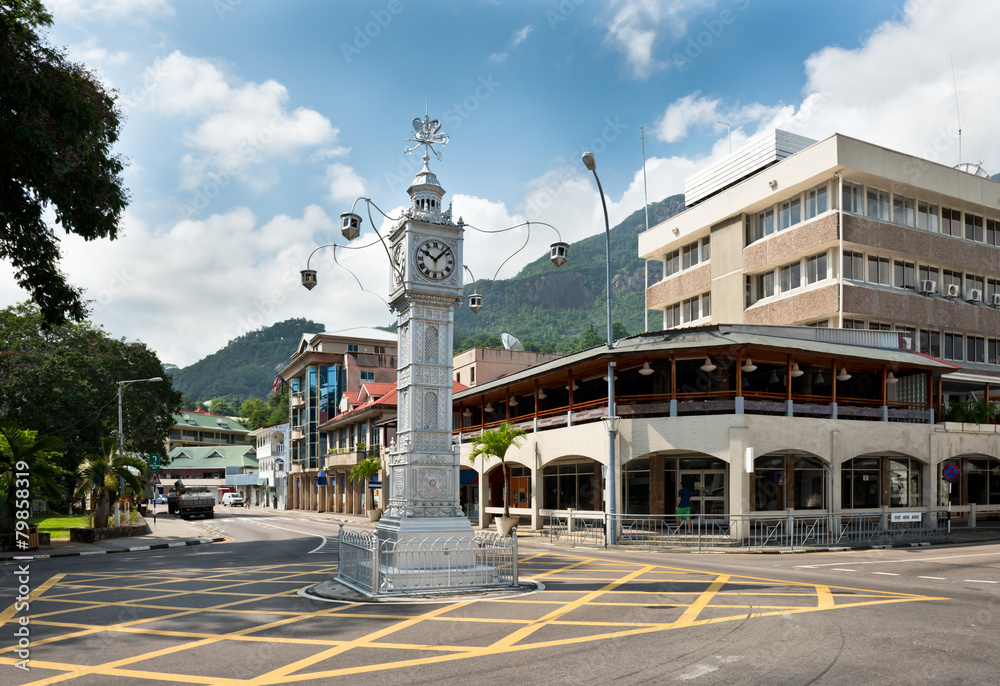Geography
Seychelles is an island State located in the South-Western Indian Ocean. The total land area of Seychelles is 455.3 square kilometres, consisting of 115 islands. The exclusive economic zone of Seychelles covers an impressive 1.374 million square kilometres of the Indian Ocean.
With a land area of 148 square kilometres the island of Mahe, the biggest island of the archipelago and the seat of the Government, constitutes about one-third of the total land area. The two other islands of major importance as to size and population are Praslin and La Digue; 33.6 km and 48 km from Mahe, respectively.
The population of Seychelles originates from French and British settlers, African plantation workers and traders from India, China and the Middle East. The population of the Seychelles stood at just over 81,000 at the end of the year 2002. Christianity is the dominant religion, with some 86% of the population Roman Catholic and 7% Anglican.
History
The Arab traders were the first to have spotted the islands, the French were the first settlers. Later on during the 16th century the islands were frequented and some were even named by the Portuguese. The French took possession of Seychelles in 1742, they started settlement permanently in 1770 and ruled Seychelles for 40 years. Pierre Poivre started the first plantation industry in Seychelles in 1771 to compete with the Dutch in the European spice trade. From 1794 and for the next thirteen years which followed, the islands changed hands seven times between the French and the British. In 1814 the Treaty of Paris incorporated both Seychelles and Mauritius as part of the British Empire. In 1903 Seychelles formally attained the status of a separate British Crown Colony.
Seychelles attained Independence from the British in 1976. In 1992 Seychelles became a multi-party democracy. A new Constitution was promulgated in June 1993 subsequent to its approval through a national referendum. Seychelles is currently divided into twenty-five political districts, each with a seat at the National Assembly.
Economy
The three most important sectors of the economy of Seychelles are fisheries, tourism and the rapidly developing offshore financial services sector.
The export of canned tuna, fresh and frozen fish constitutes about 83% of the value of Seychelles` exports of goods or about 10% of total foreign exchange earnings.
Seychelles is clearly one of the most beautiful and exclusive holiday destinations in the world. As such, the country derives a considerable part of its income from tourism. Quite uniquely, Seychelles has consistently applied a very careful approach in order not to degrade itself into a mass-tourism location and preserve its unique nature and character. Therefore, a holiday in Seychelles may be somewhat expensive – but it is well worth the money.
Since the introduction of its International Business Companies Act in 1994, Seychelles has rapidly gained worldwide recognition and popularity as one of the most competitive locations for offshore company incorporations. As of now, the offshore corporate and financial services sector is probably the most dynamic and rapidly developing sector of the national economy in Seychelles.
An increasingly important part of the Seychelles economy is the Seychelles International Trade Zone (SITZ), consisting of an increasing number of companies involved in the light manufacturing, processing and re-distribution, light assembly, internet order processing, management service operations and other technology oriented businesses.
The private sector in Seychelles currently employs just under 60% of the country`s population.
In spite of the numerous constraints related to its small size, Seychelles successfully manages its economic and social development in a sustainable and environmentally-friendly way and is the most economically prosperous country in its region.
Climate
The Seychelles islands lie outside the cyclone belt but receive monsoon rains from November to February with the northwest trade winds. This hot (31°C) and humid season (90% relative humidity) gives way to a period of cooler weather from May to September though the temperature rarely falls below 23°C, and rougher seas when the trade winds blow from the southeast. Unlike some other offshore jurisdictions, Seychelles does not get ravaged by often tropical cyclones and tornadoes, thus ensuring a constant operation of its communications and services networks.
Air Services
The Seychelles is linked to major European destinations (London, Munich, Paris, Zurich, Rome etc) as well as to the Persian Gulf and India (Dubai and Mumbai respectively), Asia (Singapore) and South Africa (Johannesburg). Air Seychelles, British Airways, Air France, Condor, Air Mauritius, Kenya Airways and South African Airways ensure more than one hundred flights per week to and from the Seychelles.
Telecommunications
International communications are provided by two international companies: Cable & Wireless and AirTel. The competition ensures a reliable level of communications, as both companies provide fixed line and mobile phone services. There are two leading Internet Service Providers (Atlas and Kokonet) ensuring a rapid development of internet coverage.
Financial Services and Transactions
These are offered by numerous banks established in the capital, Victoria, and for many they also offer decentralised services on Mahe, Praslin and La Digue, the major islands. Barclays, Nouvobanq and Banque Francaise Commerciale are among the most recognized international names. Barclays Bank Seychelles, in particular, is well specialized in providing banking services to international clients and offshore companies.
The national currency is Seychelles Rupee (SCR) and has fairly stable exchange rates against the major world currencies. The reference currency in the offshore services sector, including payment of the official IBC fees to the Government, is US dollar.
Ready to work with us?
We listen. We talk in plain language. We’re human. And we’re here to help.
